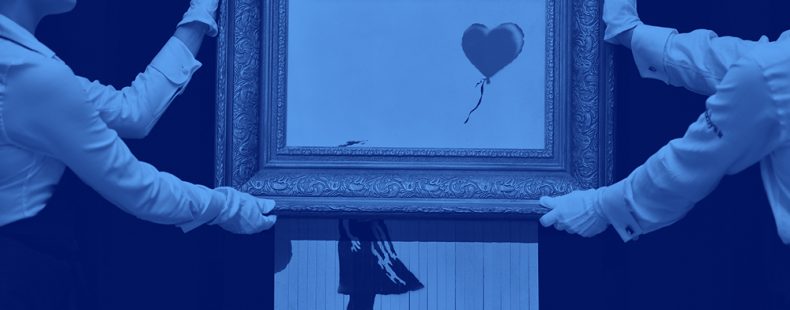Images of Street Art Images of Graffiti on the Streets
"Street Art" vs. "Graffiti": What'due south The Divergence?
Published September 14, 2020

Now more than than e'er before, public art is on the ascent. New murals crop upwardly in cities, big and pocket-size, on what feels like an everyday basis, each 1 breathing new, vibrant life into the streets that were once blank canvases for creativity. The terms graffiti and street art have long been used interchangeably to describe these public art installations—but what should we actually call them? Is there a divergence?
If you've ever plant yourself wondering if the manner you refer to your favorite public art is accurate, y'all're certainly not lone. Let's explore the origins of graffiti and street art, the similarities the two share, and the primal differences that set them autonomously.
What is graffiti?
Depending on who you inquire, graffiti is either a class of vandalism, or a class of fine art—or both, simultaneously. Past definition, graffiti refers to markings, photos, words, initials, or drawings that have been spray-painted, sketched, or fifty-fifty scratched onto walls, sidewalks, or any other publicly accessible areas. It'due south pretty common to hear someone refer to any and all of these instances as "graffiti," but as it turns out, the word graffiti is actually a plural substantive. So if there'southward only one, information technology'southward technically considered to exist a single graffito .
Derived from the Italian word with the same spelling, graffito translates to "incised inscription or design," and is a derivative of graffiare, which means "to scratch." Though gimmicky graffiti is most commonly created through spray-painting methods, historic works of graffiti—many of which can exist traced as far back every bit the beginnings of human culture— were scratched into cave walls and monuments with abrupt objects like stones.
Graffiti over time
The graffiti we're familiar with today, such equally tagging of names, kickoff began appearing overnight on underground subway cars in major cities like New York and Philadelphia as early as the 1920s. Graffiti is most commonly created illegally, which contributes to the art course's negative reputation rooted in law-breaking, malversation, and rebellion against potency.
Graffiti's presence isn't always negative, though. Throughout history, graffiti has been continually used every bit a vessel for political and social activism, particularly amidst those who have long been silenced or purposefully omitted from larger societal conversations. In the 1980s Keith Haring used graffiti to comment on the drug epidemic and AIDS crisis, and more than recently, Tatyana Fazlalizadeh has created messages addressing gender inequality. While technically, such graffiti is a course of illegal vandalism, it arguably serves every bit a necessary disruption to daily life, forcing people to pay more attention to specific problems.
What is street art?
In contrast, street fine art is, quite literally, fine art that can be found on the street. Defined equally "public-space artwork that's created for consumption exterior of the typical art gallery setting," street art is substantially synonymous with "public fine art" as information technology encompasses a variety of mediums like painting, sculpture, or stained glass.
This intentionally wide definition is key to understanding the telescopic of what street fine art covers, simply public murals are by far the most common form of street fine art. These expansive, often larger-calibration works of art typically painted on open walls or sides of buildings are near frequently created in partnership with companies, brands, or local organizations, but accept as well at times been commissioned by city officials to discourage and foreclose illegal graffiti.
So, if a public mural is considered street fine art, does that hateful graffiti is also a form of street art? The answer is: sort of.
Because they are then similar, graffiti and street art are oftentimes conflated and used interchangeably—fifty-fifty in some artistic circles. Merely technically, graffiti and street art are both subversive art movements on their ain, and graffiti actually predates the modernized murals we more often than not see in cities today.
The exact origin of the term street art remains ambiguous, simply the stardom between graffiti and street art became clearer inside the mainstream art world during the 1970s and '80s, possibly due to the fact emerging street artists who wanted a way to differentiate their work. In fact, many of the earliest street artists and muralists either drew inspiration from or started out as graffiti artists themselves before making the switch.
Today, these murals and other forms of sanctioned street art are still largely perceived equally more than socially adequate and legitimate than graffiti, but their presence in cities around the world remains complicated.
What are the central differences betweenstreet art and graffiti?
Street fine art and graffiti overlap in many ways, but the fundamental differences between the 2 lie in technique and intent.
In terms of technique, street art tends to exist image-based, whereas graffiti is more unremarkably give-and-take-based. Tagging, for example, is the most basic output of traditional graffiti writing, where artists repeatedly employ a unmarried symbol, word, or series of messages every bit their own personalized signature or "tag." These "urban autographs" were first used by gangs looking to mark their territory, but take since evolved and served equally a springboard into newer, more than intricate forms of graffiti.
The more than elaborate imagery of street art—specifically murals—is often what makes it more appreciable in the eyes of businesses and community organizations, while graffiti can frequently be perceived as difficult to read or understand past people who are not familiar with it. Additionally, graffiti artists are frequently cocky-taught, while street fine art is by and large created by trained artists (though that's not always the case).
Regarding intent, graffiti artists are, in full general, unconcerned with the public's reaction to their piece of work. Graffiti isn't virtually pleasing or connecting with the masses—alongside its function equally an internal language, it is largely a ways of self-expression.
In contrast, street art is created with a specific public audience in heed, especially when information technology'southward commissioned by businesses, local organizations, or metropolis officials. Street artists and muralists ofttimes aim to provoke audience interest and interaction through their work, or at the very least, a certain degree of understanding or appreciation for any information technology is they're trying to convey.
How to utilise the terms graffiti and street art
So, what is the difference between graffiti and street art? An exact, black-and-white answer might be difficult to pinpoint.
As tempting as it might be to endeavor to split up street art and graffiti into two peachy piffling boxes, the truth is that the two art forms accept long been intertwined since the very commencement, and are often hard to untangle from situation to state of affairs. Artists themselves may also accept varying personal definitions for the two terms based on how they prefer their piece of work to be categorized, or fifty-fifty intentionally create public art installations that take characteristics of both graffiti and street art.
Much of U.k.-based street art icon Banksy's work is the perfect example of this. Known for his political and anti-war street fine art, the creative person creates all of his work illegally while working nether the allonym of "Banksy" to avoid arrest. This lonely would classify his creations as graffiti, but consider the fact that much of his work is also image-based, with the specific intention of engaging and speaking to the general public, and the lines are quickly blurred.
Art is, and always volition be, subjective to some caste. Art isn't bars to any strict definitions of language, but that is arguably the beauty of information technology. Equally American creative person Raymond Salvatore Harmon nicely sums information technology upwardly: "The shape of art and its function in order is constantly changing. At no point is fine art static. There are no rules."
- If y'all thought you knew all there was to know about fine art and colour, take this color spelling quiz to test your knowledge.
- And so check out this slideshow on the 15 shades of green, yes 15! Which is your favorite?

pellerinhaded1983.blogspot.com
Source: https://www.dictionary.com/e/street-art-vs-graffiti/
0 Response to "Images of Street Art Images of Graffiti on the Streets"
Postar um comentário